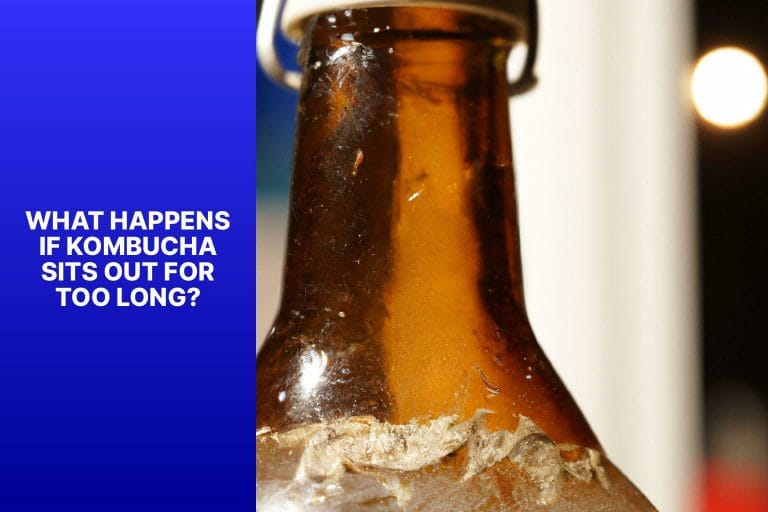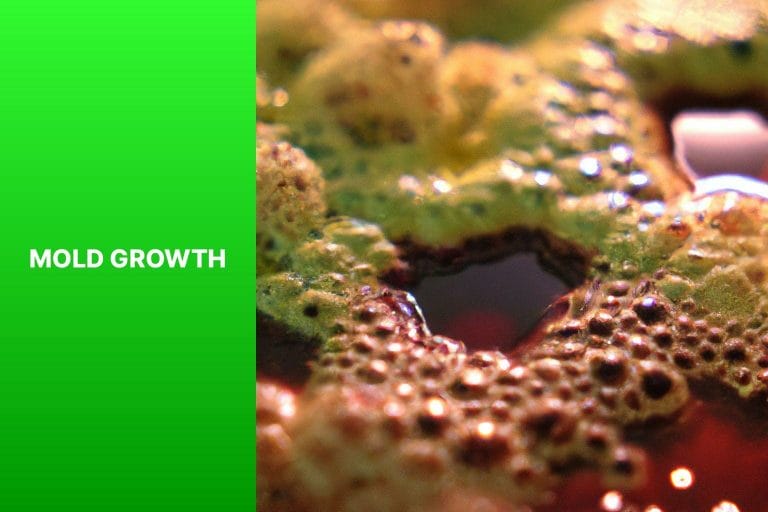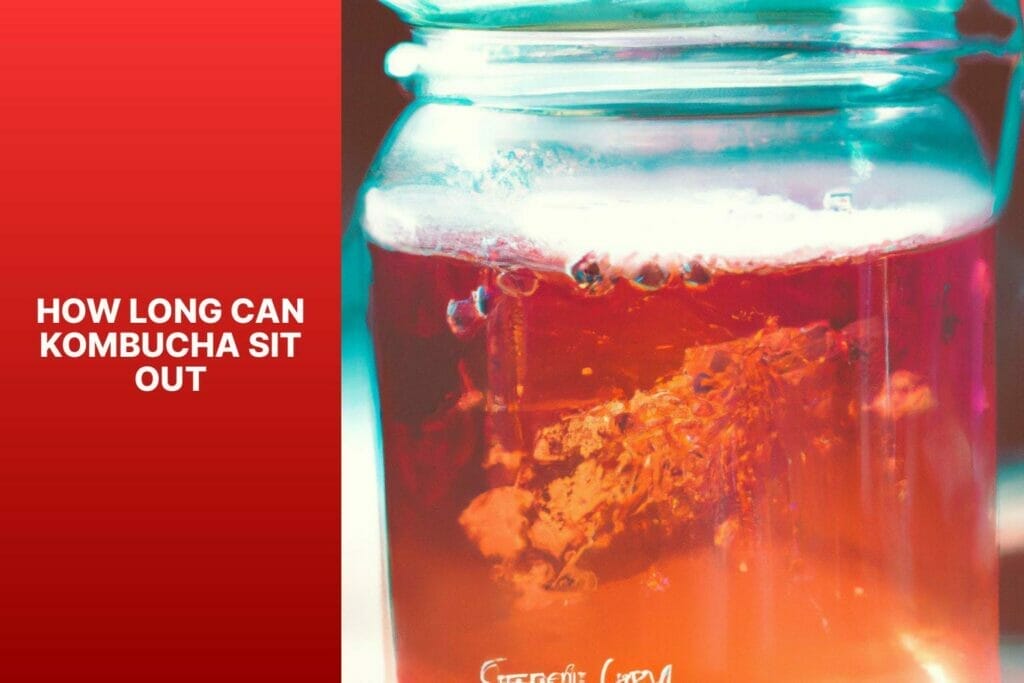Kombucha is a popular fermented tea beverage that has gained popularity for its potential health benefits. Understanding how long kombucha can sit at room temperature is essential to ensure its safety and quality.
It’s important to know what kombucha is and how it is made. Kombucha is a fermented drink made from sweetened tea that undergoes a fermentation process using a SCOBY (Symbiotic Culture of Bacteria and Yeast).
Several factors consider how long kombucha can sit out at room temperature. The fermentation process is the key determinant, and the optimal brewing time varies depending on personal preference.
Generally, kombucha is left to ferment for 7-14 days.
If kombucha sits out for too long, several issues can arise. Over-fermentation may occur, leading to increased acidity and potential changes in taste and quality.
Leaving kombucha out for an extended period can allow unwanted microorganisms to grow, compromising its safety and flavor.
To properly store kombucha, it is recommended to refrigerate it after the desired fermentation time to slow down the fermentation process and maintain its taste and quality.
Signs of spoiled kombucha include mold growth, a foul smell, and a color change. If you notice any of these signs, discarding the kombucha to avoid potential health risks is best.
Key takeaway:
- Kombucha is a fermented tea and sugar drink known for its health benefits.
- Proper fermentation of kombucha requires specific brewing time and temperature conditions.
- Leaving kombucha at room temperature for too long can lead to over-fermentation, impacting taste and quality.
- Extended exposure to air may result in the growth of unwanted microorganisms, such as molds.
- Drinking kombucha left out for a long time is not recommended due to potential health risks.
What Is Kombucha?
Kombucha, also known as the “tea of immortality,” is a fermented beverage consumed for thousands of years and originated in China.
It combines tea, sugar, and a symbiotic culture of bacteria and yeast (SCOBY).
This unique combination results in a naturally carbonated drink rich in probiotics, which are beneficial bacteria supporting gut health and digestion.
Fermentation converts the sugar into organic acids, giving kombucha a tangy and slightly sweet flavor.
Kombucha contains antioxidants that help protect against oxidative stress and inflammation.
While popular flavors include ginger, raspberry, and lavender, kombucha can also be enjoyed plain.
Kombucha offers a delicious and healthy option for those looking to incorporate probiotics into their diet.
How Is Kombucha Made?
Kombucha is a fermented tea made through several steps. Here is the process:
1. How Is Kombucha Made? Prepare the tea: Brew a strong batch using black or green tea leaves.
2. Add sugar: Dissolve a specific amount of sugar, typically 8-10% of the total liquid volume, while the tea is hot.
3. Cooldown: Let the sweetened tea cool to room temperature.
4. Add the SCOBY: Place a symbiotic culture of bacteria and yeast (SCOBY) into the cooled sweet tea to start fermentation.
5. Fermentation: Cover the vessel with a breathable cloth or coffee filter to let air circulate, preventing dust and insects from entering. Leave the vessel undisturbed in a warm and dark location for about a week or until the desired taste is achieved.
6. Secondary fermentation: After the initial fermentation, enhance the taste by adding fruits, herbs, or spices. Place these ingredients into a sealed bottle or jar for a second fermentation process.
7. Bottling: Strain out any solid particles and pour the fermented kombucha into clean, airtight bottles. Store the bottles in a cool place to allow slow carbonation over time.
Following these steps, kombucha enthusiasts can make their probiotic-rich, tangy, and refreshing beverage.
How Long Can Kombucha Sit Out at Room Temperature?
Regarding kombucha, one burning question lingers: how long can it sit out at room temperature? This section reveals the secrets behind the fermentation process and the optimal brewing time.
Get ready to dive into the fascinating world of kombucha, where the perfect balance of time and Temperature transforms a simple beverage into a delightful elixir. So, grab your favorite flavor, and explore the art of kombucha brewing together!
Fermentation Process
The fermentation process is crucial in making kombucha. Here are the steps involved:
- Brew sweet tea: Start by brewing black tea and sugar. Steep the tea and add sugar to feed the yeast and bacteria during fermentation.
- Add SCOBY: After the sweet tea mixture has cooled down, add a gelatinous disc called SCOBY (Symbiotic Culture of Bacteria and Yeast). SCOBY initiates the fermentation process and comprises beneficial bacteria and yeast.
- Executing the fermentation process is where the magic happens. The SCOBY consumes sugar and converts it into various acids, like acetic acid and gluconic acid, and other compounds that give kombucha its unique taste. This fermentation process takes 7-10 days, but the time can vary based on Temperature and desired taste.
- Carbonation: Once the fermentation time is reached, transfer the kombucha to airtight bottles or containers for a second round of fermentation. This allows natural carbon dioxide buildup, resulting in the characteristic fizziness of kombucha.
- Flavoring: After the second fermentation, you can add fruit, herbs, or spices to enhance the taste of kombucha. This step is optional and depends on personal preference.
Pro-tip: Maintain a clean and sterile environment during fermentation to prevent contamination. Regularly monitor the pH and taste to determine when the fermentation process is complete, and the kombucha is ready to be consumed.
Optimal Brewing Time
The optimal brewing time for kombucha greatly influences its taste and quality. To achieve the best results, follow these steps:
1. Ferment for 7-10 days: During this period, the SCOBY consumes the most sugar and develops the desired tangy flavor.
2. Conduct a taste test: Use a clean spoon to sample the kombucha after the initial fermentation. This will allow you to assess its flavor and determine if it requires more time to ferment.
3. Perform a secondary fermentation: To create a stronger and more carbonated kombucha, carry out a secondary fermentation. Transfer the kombucha into airtight bottles or jars and let them sit at room temperature for 1-3 days. This step enhances carbonation and creates a fizzy texture.
4. Conduct another taste test: After the secondary fermentation, sample the kombucha again to ensure it has reached your desired flavor. If satisfied, refrigerate the kombucha to slow fermentation and preserve its quality.
Kombucha has a rich history dating back to ancient China, where it was believed to possess detoxifying and energizing properties. Over time, the optimal brewing time has been perfected to strike a balance between tanginess and sweetness. Nowadays, kombucha enthusiasts enjoy experimenting with different brewing times to achieve their preferred taste and carbonation levels.
What Happens If Kombucha Sits Out for Too Long?

Photo Credits: Standardkombucha.Com by Adam Taylor
If you’ve ever wondered what happens when kombucha sits out too long, brace yourself for some interesting revelations.
From over-fermentation to changes in taste and quality, growth of unwanted microorganisms, foul smells, and even color changes, we’ll explore the potential consequences of neglecting your booch brew.
So, let’s dive into the intriguing world of kombucha and uncover what lies in store when it stays unattended for an extended period. Prepare yourself for a wild ride of unexpected outcomes!
Over Fermentation
Over-fermentation in kombucha results from prolonging the brewing process beyond the recommended period. This can lead to several undesired outcomes.
One consequence of over-fermentation is increased acidity, which gives the kombucha a sour taste that may not be pleasant for everyone.
Over-fermentation can cause the alcohol content of the kombucha to rise, which may be undesirable for individuals who want to avoid alcohol.
Another effect of over-fermentation is the reduction of carbonation levels, resulting in a flatter and less effervescent drink.
Prolonged fermentation can alter the taste and quality of the kombucha, causing it to become overly tart or develop off-flavors.
Over-fermentation diminishes the probiotic content of the kombucha, thereby reducing its health benefits.
To prevent over-fermentation, it is essential to closely monitor the brewing time and adhere to the recommended guidelines. Each batch of kombucha may require a different optimal brewing time, so it is advisable to taste and test the kombucha during fermentation regularly.
If you accidentally over-ferment your kombucha, it is generally advised to discard it to ensure optimal taste and quality. Starting fresh with a new batch will guarantee a well-balanced and enjoyable brew.
Always remember to store kombucha properly in a cool and dark place and consume it within a reasonable timeframe to preserve its taste and quality.
Changes in Taste and Quality
Changes in Taste and Quality can occur when kombucha is left out for too long.
– The taste of kombucha can become more acidic and vinegary if left out for an extended period.
– The quality of the kombucha may deteriorate, leading to a less enjoyable drinking experience.
– The carbonation in the kombucha may decrease, resulting in a flatter texture.
– The flavor profile of the kombucha can change, with some original flavors becoming more pronounced or overpowering.
These changes occur due to the fermentation process happening in the bottle. As yeast and bacteria consume sugars in the kombucha, they produce more acids and flavors. When kombucha sits out too long, the balance of flavors and acidity can become imbalanced, resulting in a less desirable taste. Extended exposure to air can potentially introduce unwanted microorganisms, further affecting the quality of kombucha. Therefore, consuming kombucha within a reasonable time is best to enjoy its optimal taste and quality.
Growth of Unwanted Microorganisms
Unwanted microorganisms can inevitably experience growth in kombucha if it is left out for an extended period. These microorganisms encompass harmful bacteria or yeast that have the potential to lead to spoilage or illness.
These unwelcome microorganisms grow in kombucha primarily due to sugars and essential nutrients. As time passes, the conditions become increasingly favorable for their multiplication.
Consequently, an overgrowth of bacteria or yeast can occur, resulting in undesirable fermentation.
It is crucial to note any visual changes in kombucha, such as the appearance of mold, a pungent odor, or a color shift, as these signs can indicate the presence and growth of unwanted microorganisms.
If kombucha has been left out for an extensive period and exhibits signs of this growth, it is strongly advised against consuming it.
Indeed, ingesting kombucha contaminated with harmful microorganisms can pose significant health risks.
Mold Growth

Photo Credits: Standardkombucha.Com by Juan King
Mold growth can occur in the environment while storing kombucha if there is improper control or contamination. To minimize the risk of mold growth, it is essential to thoroughly clean and sanitize all equipment and containers. Storing kombucha in a clean and dry environment is crucial.
Discarding the entire batch is important to avoid potential health risks if mold develops. Consumption of mold-contaminated kombucha can have adverse effects due to the harmful toxins produced by the mold.
Hence, regular inspection of the kombucha is necessary to identify signs of mold, such as discoloration, fuzzy patches, or off-putting odors. If any of these signs are present, it is best to discard the entire batch to ensure safety.
Following proper cleaning and storage practices, you can significantly reduce the risk of mold growth in your kombucha and enjoy a safe and healthy beverage.
Foul Smell
The foul smell in your kombucha indicates that it may have spoiled and is no longer safe for consumption. Prolonged fermentation can change the drink’s taste and quality, creating an environment that promotes the growth of undesirable microorganisms and generates a distinctly unpleasant odor.
If your kombucha exhibits a strong and disagreeable scent, discarding it to avoid potential health risks is strongly advised.
The mold growth or a noticeable change in the color of the kombucha are additional signs of spoilage. Taking the appropriate steps to ensure proper storage is crucial in preventing such spoilage incidents.
With its extensive historical background dating back centuries, kombucha first emerged during the Qin dynasty in China around 220 BCE.
This unique beverage, resulting from the fermentation of tea with a SCOBY (symbiotic culture of bacteria and yeast), gradually spread across various regions in Asia, gaining popularity in Europe and North America.
Kombucha is relished worldwide for its distinctive flavor and the potential health benefits it offers.
Change in Color
Kombucha can experience a color change, which may indicate potential issues. Here are some reasons for these color changes:
- Oxidation: If kombucha is exposed to air for an extended period, it can oxidize and turn brown, affecting its taste and overall quality.
- Mold Growth: Green, black, or fuzzy patches on the surface indicate mold growth. It is important to note that consuming moldy kombucha can be hazardous to your health.
- Added Ingredients: Certain added flavors or additives can naturally alter the color of kombucha. For instance, fruits like berries or beets can give them a reddish or purple hue.
- Fermentation Issues: Improper control of the fermentation process can result in kombucha having an off-color appearance. Over-fermentation or the growth of unwanted microorganisms can contribute to this issue.
There is a real incident involving an amateur kombucha brewer who accidentally left a bottle on the kitchen counter for a few weeks.
Upon opening it, the kombucha had turned blue. Further research revealed that the blue color was likely a result of a reaction between the kombucha’s acids and a copper water supply line in the kitchen.
Can You Still Drink Kombucha That Has Been Left Out for A Long Time?
Drinking kombucha that has been left out for a long time is not safe. When left at room temperature for an extended period, harmful bacteria can grow, leading to spoilage and the formation of toxins that can cause foodborne illnesses.
If your kombucha has been left out for more than a few days, it is advisable to discard it. Consuming spoiled kombucha can result in symptoms such as nausea, vomiting, diarrhea, and stomach cramps.
Prioritizing your health and safety when consuming fermented foods and beverages is crucial.
Fact: Kombucha can be stored in the refrigerator for several weeks to preserve its flavor and quality.
Some Facts About How Long Kombucha Can Sit Out:
- ✅ Leaving kombucha outside the refrigerator for a few hours or days will not significantly affect its taste, but longer periods can cause fermentation and alter the flavor. (Source: The Culture Ko)
- ✅ kombucha should always be refrigerated because it is unpasteurized and contains beneficial bacteria that will continue to ferment at room temperature. (Source: My Recipes)
- ✅ Temperature affects the fermentation process of kombucha, with higher temperatures leading to faster fermentation and changes in taste, carbonation, caffeine content, and alcohol content. (Source: The Culture Ko)
- ✅ The longer kombucha is left out, the more the live bacteria reduce the caffeine content and increase the alcohol content. (Source: Rise Kombucha)
- ✅ If left at room temperature for an extended period, kombucha will become too sour to consume within 7-10 days, depending on the Temperature. (Source: The Culture Ko)
